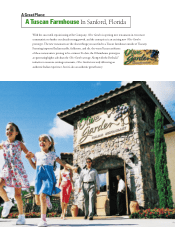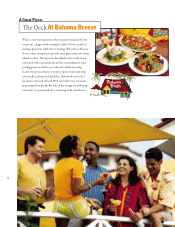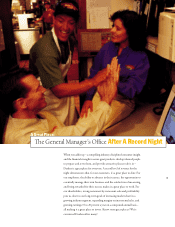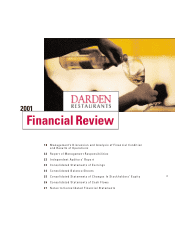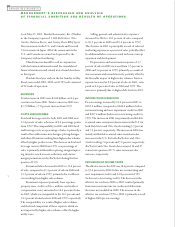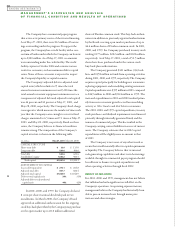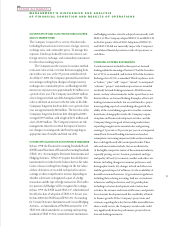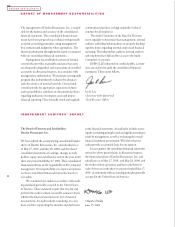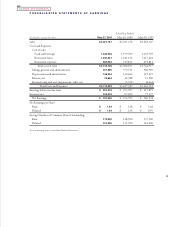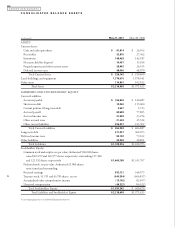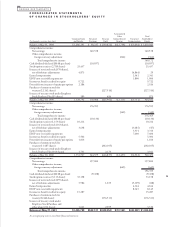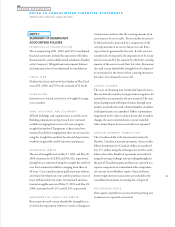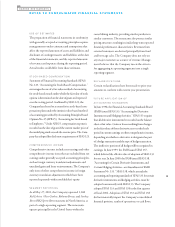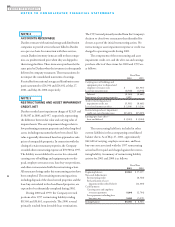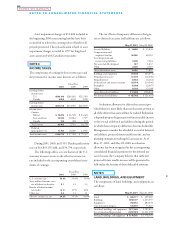Red Lobster 2001 Annual Report Download - page 23
Download and view the complete annual report
Please find page 23 of the 2001 Red Lobster annual report below. You can navigate through the pages in the report by either clicking on the pages listed below, or by using the keyword search tool below to find specific information within the annual report.
MANAGEMENT’S DISCUSSION AND ANALYSIS
OF FINANCIAL CONDITION AND RESULTS OF OPERATIONS
QUANTITATIVE AND QUALITATIVE DISCLOSURES
ABOUT MARKET RISK
The Company is exposed to a variety of market risks,
including fluctuations in interest rates, foreign currency
exchange rates, and commodity prices. To manage this
exposure, Darden periodically enters into interest rate,
foreign currency exchange, and commodity instruments
for other than trading purposes.
The Company uses the variance/covariance method
to measure value at risk, over time horizons ranging from
one week to one year, at the 95 percent confidence level.
As of May 27, 2001, the Company’s potential losses in future
net earnings resulting from changes in foreign currency
exchange rates, commodity prices, and floating rate debt
interest rate exposures were approximately $1 million over
a period of one year. The Company issued $225 million
of new long-term fixed rate debt during fiscal 2001. The
value at risk from an increase in the fair value of all of the
Company’s long-term fixed rate debt, over a period of one
year, was approximately $40 million. The fair value of the
Company’s long-term fixed rate debt during fiscal 2001
averaged $359 million, with a high of $472 million and
a low of $229 million. The Company’s interest rate risk
management objective is to limit the impact of interest
rate changes on earnings and cash flows by targeting an
appropriate mix of variable and fixed rate debt.
FUTURE APPLICATION OF ACCOUNTING STANDARDS
In June 1998, the Financial Accounting Standards Board
(FASB) issued Statement of Financial Accounting Standards
(SFAS) 133, “Accounting for Derivative Instruments and
Hedging Activities.” SFAS 133 requires that all derivative
instruments be recorded on the balance sheet at fair value.
Gains or losses resulting from changes in the fair values
of those derivatives are recorded each period in current
earnings or other comprehensive income, depending on
whether a derivative is designated as part of a hedge
transaction and the type of hedge transaction. The ineffec-
tive portion of all hedges will be recognized in earnings.
In June 1999, the FASB issued SFAS 137, which deferred
the effective date of adoption of SFAS 133 for one year.
In June 2000, the FASB issued SFAS 138, “Accounting
for Certain Derivative Instruments and Certain Hedging
Activities - an Amendment of FASB Statement No. 133.”
SFAS 138, which amends the accounting and reporting
standards of SFAS 133 for certain derivative instruments
and hedging activities, must be adopted concurrently with
SFAS 133. The Company adopted SFAS 133 and SFAS 138
in the first quarter of fiscal 2002. Adoption of SFAS 133
and SFAS 138 did not materially impact the Company’s
consolidated financial position, results of operations, or
cash flows.
FORWARD-LOOKING STATEMENTS
Certain statements included in this report are forward
looking within the meaning of Section 27A of the Securities
Act of 1933, as amended, and Section 21E of the Securities
Exchange Act of 1934, as amended. Words or phrases such
as “believe,” “plan,” “will,” “expect,” “intend,” “is anticipated,”
“estimate,” “project,” and similar expressions are intended
to identify forward-looking statements. All of these state-
ments, and any other statements in this report that are not
historical facts, are forward looking. Examples of forward-
looking statements include, but are not limited to, projec-
tions regarding expected casual dining sales growth; the
ability of the casual dining segment to weather economic
downturns; demographic trends; the Company’s expan-
sion plans and business development activities; and the
Company’s long-term goals of increasing market share,
expanding margins on incremental sales, and growing
earnings 15 percent to 20 percent per year on a compound
annual basis. Forward-looking statements are based on
assumptions concerning important risks and uncertainties
that could significantly affect anticipated results. These
risks and uncertainties include, but are not limited to,
(i) the highly competitive nature of the restaurant industry,
especially pricing, service, location, personnel, and type
and quality of food; (ii) economic, market, and other con-
ditions, including changes in consumer preferences and
demographic trends; (iii) changes in food and other costs
and the general impact of inflation; (iv) the availability of
desirable restaurant locations; (v) government regulations,
including those relating to zoning, land use, environmen-
tal matters, and liquor licenses; and (vi) growth plans,
including real estate development and construction
activities, the issuance and renewal of licenses, and permits
for restaurant development and the availability of funds
to finance growth. If the Company’s projections and
estimates regarding these key factors differ materially from
what actually occurs, the Company’s actual results could
vary significantly from the performance projected in its
forward-looking statements.
21
2001
DARDEN RESTAURANTS


